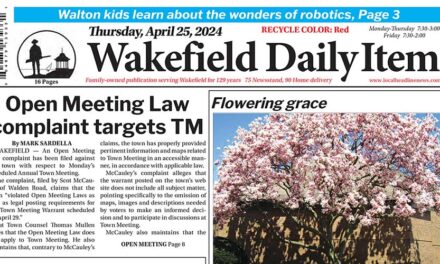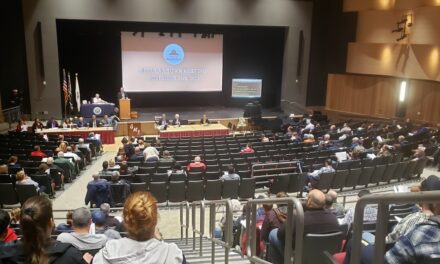Published in the March 26, 2021
By MARK SARDELLA
WAKEFIELD — The Town Council voted this week to place an article on the May 8 Annual Town Meeting warrant asking voters to adopt something called the “Stretch Energy Code.”
Massachusetts gives communities two options for their building energy code – a base energy code or an optional stretch energy code. Municipalities can choose to adopt the stretch energy code by vote of City Council or Town Meeting and it can be rescinded by these bodies as well. Adoption of the Stretch Code is one of the requirements for the town of Wakefield to apply for designation as a Green Community and thus be eligible for grants to pay for energy saving projects in town buildings.
According to advocates, a key feature of the Stretch Energy Code is that it is performance based. It requires new homes to meet a HERS (Home Energy Rating System) index rating target, rather than requiring the installation of specific levels of energy efficiency for each building element (e.g. windows, wall insulation, roof insulation, furnace etc). The HERS rating is a measure based on a home’s total expected energy use and overall efficiency. It is calculated by a certified HERS rater using accredited software, which uses information on the design of the energy systems in a home to calculate the annual energy needs of the home and give it a rating score.
Neal Duffy, Regional Coordinator for the Green Communities Division at the Massachusetts Department of Energy Resources, spoke during Monday’s Zoom meeting. He told the Town Council that 288 Massachusetts communities have adopted the Stretch Code and 271 have been designated as “Green communities.”
Mike Berry of ICF International said that the Stretch Code only applies to new construction of residential and commercial buildings and would not apply to renovations of additions to existing buildings.
Berry said that while there is an additional cost associated with meeting the Stretch Code, that cost is recoverable in energy savings.
Town Councilor Edward Dombroski said that he was not opposed to adopting the Stretch Code, but he thought that the council should at least hear arguments on both sides before recommending adoption by the town.
Berry suggested soliciting feedback from the town’s Building Department or neighboring communities.
——
School administrators presented their FY 2022 budget to the Town Council this week. While the Town Council does not vote on the school budget, they typically weigh in on how the budget fits with the overall town budget.
The School Department is requesting a $45,703,200 budget for Fiscal Year 2022, which represents an increase of $2,126,541 (4.88 percent) over the current year. School Business Administrator Christine Bufagna went over budget numbers. Personnel costs account for the lion’s share of the budget at $38,337,867, she said. There is another $5,432,661 listed under Contractual Services and $1,932,672 in Materials and Supplies.
Bufagna noted that the School Department in FY 2021 received $1,451,792.50 in one-time COVID-19 grants, but incurred $1,739,631 in COVID-related costs for things like PPE and facilities updates, overtime custodial and nursing costs ($287,000 and $138,000, respectively) as well as building maintenance and supplies ($150,000).
She talked about some of the budget priorities for FY 2022, including addressing learning loss at all grade levels due to pandemic. She also pointed to a need for extended day for intervention services and technology supports to maintain initial investments.
Safety and health services, direct instruction, intervention, remote services and counseling are now top priorities, she said, and PPE with modified work spaces and cleaning routines will continue to be required.
Town Councilor Jonathan Chines called the budget “responsible and reasonable.” He asked about the additional cost listed for running the Doyle early Childhood Center.
Bufagna explained the program was normally sustained by paid tuition but with enrollment down due to the pandemic, funding had to be supplemented through the budget.
Councilor Edward Dombroski asked about the “temporary” COVID-related positions in the budget. He also pointed out that the budget is primarily driven by contractual salary obligations. From a taxpayer perspective, he observed, it’s what is negotiated in these contracts that drives tax increases in town.
——
The Town Council approved the FY 2022 Health Insurance budget.
Town Accountant Kevin Gill said that the budget was up $638,987 over the current year, for a total of $14,284,954.
Town Administrator Stephen P. Maio said that GIC rates went up 4 percent this year. He noted that costs will likely be reduced during open enrollment as members select less expensive plans. He said that he anticipated that the Health Insurance budget would return as much as $500,000 to the general fund at the end of the fiscal year.
Don Ravenelle from the Finance Committee said that the subcommittee that reviewed the Health Insurance budget recommended approval.
——
The Town Council approved the CATV Public Access enterprise budget, which funds WCAT and the high school TV production program. Gill explained that this budget is funded by the cable companies through franchise fees paid to the town. He noted that the budget was decreased by $25,880 from the current year. He observed that as more people cut the cable cord, this budget may shrink in coming years and the town may need to subsidize the budget.
The Town Council approved the budget at a total of $551,239.
——
The Town Council approved a Capital Outlay budget of $1,982,325 for FY 2022.
——
The Town Council issued a proclamation designating April 6, 2021 as “Educational Savings Branch of The Savings Bank Day” in Wakefield in honor of the 40th anniversary of its opening, and for its contributions and commitment, not only to financial literacy and education among all students, but also to the Town of Wakefield.




